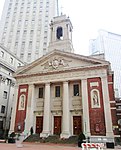City Hall station (IRT Second Avenue Line)

City Hall was a station on the IRT Second Avenue Line in Manhattan, New York City, which also served trains of the IRT Third Avenue Line. It lay along Park Row, south of the Manhattan Municipal Building, across the street from the BRT’s Park Row Terminal. It had 2 levels. The lower level served Third Avenue trains and had two tracks with two side platforms for exiting passengers, and a center island platform for entering passengers. The upper level served Second Avenue trains and had two tracks and two side platforms for exiting passengers, and one island platform for entering passengers. Second Avenue trains served the station until June 13, 1942, and Third Avenue trains served the station until December 31, 1953. The next stop to the north was Chatham Square for all trains.
Excerpt from the Wikipedia article City Hall station (IRT Second Avenue Line) (License: CC BY-SA 3.0, Authors, Images).City Hall station (IRT Second Avenue Line)
Park Row, New York Manhattan
Geographical coordinates (GPS) Address Nearby Places Show on map
Geographical coordinates (GPS)
| Latitude | Longitude |
|---|---|
| N 40.7125 ° | E -74.003666666667 ° |
Address
Sugar House Prison Window
Park Row
10000 New York, Manhattan
New York, United States
Open on Google Maps











